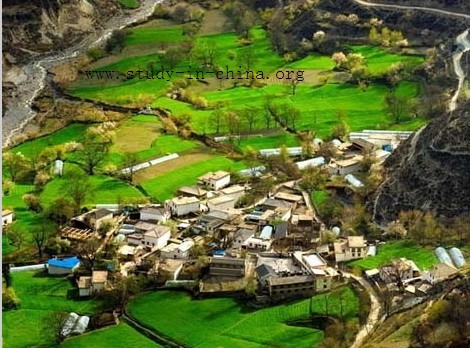more>>More News
- National Day
- ways to integrate into Chinese style life
- Should they be in the same university with me?!!
- Chinese Ping Pang Legend: the Sun Will Never Set
- A Glance of those Funny University Associations
- mahjong----The game of a brand new sexy
- Magpie Festival
- Park Shares Zongzi for Dragon Boat Festival
- Yue Fei —— Great Hero
- Mei Lanfang——Master of Peking Opera
Diqing Travel Guide
By admin on 2015-02-03
Shangri-la, a popular word after World War
II and one frequently adopted by stores, hotels and restaurants, signifies a
"heaven away from the turmoil of the mundane word". Actually, "Shangri-la" is a
Tibetan word, which means "land of sacredness and peace."
The word
"Shangri-la" first appeared in its westernized form in James Hiltom's novel The
Lost Horizon. This book tells the story of three American pilots who, when
flying over the Sino-Indian air route during World War II, crash-land in the
midst a beautiful landscape. This place of tranquility and peace is described as
having "snow mountains, grasslands, Tibetan people, red soil plateaus, with
three rivers flowing traversing the landscape". After being rescued by the local
Tibetan people, the three American pilots finally return home.
According
to the historical record, in 1944 there was indeed an American transport plane
which crashed in the town of Zhongdian within Yunnan province while flying over
the Sino-Indian air route. After a careful investigation into these events, it
was determined that the beauitful "Shangri-la" described in "The Lost Horizon"
is, in fact, the city of Zhongdian, located in the Deqen Tibentan Autonomous
Prefecture of Yunnan Province.
Even Today, Zhongdian County remains an
untainted natural paradise which retains a mysterious and bewitching
quality.Visitors to the Deqen Tibetan Autonomous Prefecture are sure to find
themselves in a land where mysterious tranquillity pervades every inch of the
ever-changing scenery.
Three snow-capped mountains, Meili, Baimang and
Haba, tower magnificently over the landscape. The region is crisscrossed by the
Golden Sand, Mekong, and Yangtze Rivers. These snowy peaks form a beautiful
backdrop whose beauty is a feast to behold. Mirror-like lakes, scattered across
the vast expanse of grassland, look like rich jewels inlaid on a beautiful
tapestry.Cattle graze leisurely in the meadows, where exotic flowers and
luxuriant grass wave at the request of the gentle breeze.In the depths of the
surrounding forests is an exotic world of rare birds and animals.
Mother
Nature has endowed Shangri-la with bountiful natural wealth, making the land a
happy home for the 100,000 Tibetans, Lisus, Naxis and Yis who call the area
their home. As is this pristine natural enviroment, these nationalities are all
kind, honest, extremely hospitable to outsiders.The lamasery of "Shangri-la" is
Guihua Temple, or Songzanlinbu Lamasery in Tibet. The lamasery, with 800 lamas,
resembles Butala Palace of Lasha in its layout. The five-story Tibetan style
building is covered with wooden carvings and gold-plated copper tiles. You may
have a look at the Gallery of Tibetan Religion and Culture in
Deqen.
Legend of Shangri-La
In. 1933, English novelist James Hilton
wrote a captivating tale of an idyllic settlement high in a secluded mountainous
valley. Entitled Lost Horizon, it describes a world often chanted pavilions
perched between the high mountains and the fertile Blue Moon Valley. Today, even
those who have never heard of Lost Horizon, the words "Shangri-La" evoke images
of utopia. Hilton said his readers would not find Shangri-La on any map but
suggested that Shangri-La was located in a long valley with "rounded, sad
looking hills on either side'' and capped by the "loveliest mountain on
Earth".
It was almost a perfect cone of snow, simple in outline as if a
child had drawn it. "Italian-American film director, Frank Capra snapped up the
tights to Lost Horizon and cast Ronald Coleman and Jane Wyatt in the 1937 film
version. ``I'm sure there's a wish for Shangri-La in everyone's heart Oh, I just
wish the whole world might come to this valley, "crooned Wyatt. The film won the
1937 Academy Award for Columbia Pictures . Ronald Coleman and Jane Wyatt in de
1937 film, Lori orison. photo and above South China Morning Post, 29, 1997
Though neither Hilton or Capra ever stepped foot in the region, many speculate
that Hilton's Loa Horizon was inspired by a series of articles published from
1924 to 1935 by National Geographic magazine - that included accounts of Joseph
F. Rock's expedition of North west Yunnan Province.

- Contact Us
-
Tel:
0086-571-88165708
0086-571-88165512E-mail:
admission@cuecc.com
- About Us
- Who We Are What we do Why CUECC How to Apply
- Address
- Study in China TESOL in China
Hangzhou Jiaoyu Science and Technology Co.LTD.
Copyright 2003-2024, All rights reserved




 Chinese
Chinese
 English
English
 Korean
Korean
 Japanese
Japanese
 French
French
 Russian
Russian
 Vietnamese
Vietnamese
